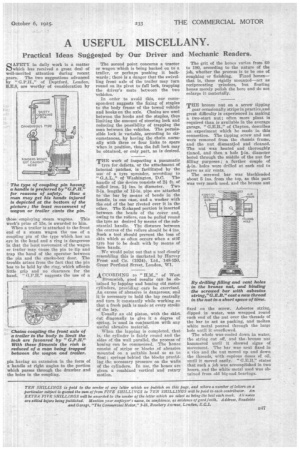A USEFUL MISCELLANY.
Page 31

If you've noticed an error in this article please click here to report it so we can fix it.
Practical Ideas Suggested by Our Driver and Mechanic Readers.
SAFETY in daily work is a matter which has received a great deal of well-merited attention during recent years. The two suggestions advanced by " G.P.H.," of Deptford, London, B.E.8, are worthy of consideration by
those employing steam wagons. This week's prize of 15s. is awarded to him.
When a trailer is attached to the front end of a steam wagon the use of a coupling pin of the type which has an eye in the head and a ring is dangerous in that the least movement of the wagon or trailer may cause the pin to tip and trap the hand of the operator between the pin and the smoke-box door. The trouble arises from the fact that the pin has to be held by the ring, which affords little grip and no clearance for the hand. " G.P.H." suggests the use of a pin having an extension in the form of a handle at right angles to the portion which passes through the drawbar and the holes in the coupling.
The second point concerns a tractor or wagon which is being backed on to a trailer, or perhaps pushing it backwards ; there is a danger that the swivelling front axle of the trailer may turn round on its pivot to full lock, trapping the driver's mate between the two vehicles.
In order to avoid this, our correspondent suggests the fixing of staples to the body frame of the towed vehicle and hooks on the axle. Chains are used between the hooks and the staples, thus limiting the amount of steering lock and reducing the possibility of trapping the man between the vehicles. The permisBible lock is variable, according to circumstances, by having the chain normally with three or four links to spare when in position, thus the full lock may be obtained, or only part, as is desired.
THE work of inspecting a pneumatic tyre for defects, or the attachment of internal patches, is facilitated by the use of a tyre spreader, according to " G.A.L.," of Washington, D.C. The haudle of the device consists of 2f ft. of rolled iron, if ins, in diameter. Two 3-in. lengths of 1i-in. pipe are attached to the bar by means of bends in the handle, in one case, and a washer with the end of the bar riveted over it in the other. The Z-shaped portion is inserted between the beads of the cover and, owing to the rollers, can be pulled round the tyre as desired by means of the substantial handle. The distance between the centres of the rollers should be 4 ins. Such a tool should prevent the loss of skin which so often occurs when a stiff tyre has to be dealt with by means of bare hands.
We would point out that a tool closely resembling this is marketed by Harvey Frost and Co. (1924), Ltd., 148-150, Great Portland Street, London, Wl.
ACCORDING to "H.M.," of West , Bromwich, good results can be obtained by lapping and honing old motor cylinders, providing care be exercised. An excess of abrasive is dangerous, and it is necessary to hold the lap centrally and turn it constantly while working so that a fresh path is made at every stroke of the lap.
Usually an old piston, with the skirt cut diagonally to give it a degree Gf spring, is used in conjunction with any useful abrasive material.
When the lapping is completed, that is, the cylinder is fairly round and the sides of the wall parallel, the process of honing can be commenced. The hones consist of strips or blocks of abrasive mounted on a suitable head so as to float ; springs behind the blocks providing the necessary pressure on the walls of the cylinders. In use, the hones are given a combined vertical and rotary motion. The grit of the hones varies from-60 to 180, according to the nature of the job, whether the process is to be one of roughing or finishing. Fixed hones— that is, those rigidly mounted—act as reciprocating grinders, but floating hones merely polish the bore and do not enlarge it materially.
THE bronze nut on a screw tipping
gear occasionally strips in practice.and great difficulty is experienced in making a two-start nut ; often more plant is required than is available in the average garage. " G.E.B.," of Clayton, describes an experiment which he made in this connection. The tipping screw and nut were removed from the chassis frame, and the nut dismantled and cleaned. The nut was heated and thoroughly tinned, and then a hole /-in, diameter bored through the middle of the nut for filling purposes ; a further couple of &in. holes were drilled at each end to serve as air vents.
The screwed bar was blackleaded about 5 ins, from the top, as this part was very much used, and the bronze nut fixed on the screw. Asbestos string, dipped in water, was wrapped round each end of the nut over the threads of the bar to act as packing, and molten white metal poured through the large hole until it overflowed.
The whole was cooled down in water, the string cut off, and thebronze nut hammered until it showed signs of movement. The bar was next fixed in a vice and the nut moved up and down the threads, with copious doses of oil, until it moved easily. " G.E.B." states that such a job was accomplished in two hours, and the white metal used was obtained from old big-end bearings.
































